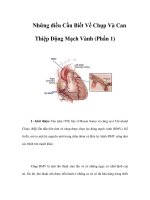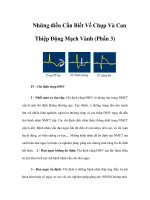Đóng rò động mạch vành vào các buồng tim
Bạn đang xem bản rút gọn của tài liệu. Xem và tải ngay bản đầy đủ của tài liệu tại đây (1.63 MB, 35 trang )
TRANSCATHETER CLOSURE OF
CORONARY ARTERY FISTULA
DR DO NGUYEN TIN
DAO ANH QUOC, MD
CHILDREN HOSPITAL 1, HCMC
AIM
• Describe the techniques used in transcatheter
closure of coronary artery fistula.
• Report our results with this procedure
• Compare our findings with those described in
the transcatheter and recent surgical
literature
INTRODUCTION
• Abnormal connection between one of the
coronary arteries and a heart chamber or
another blood vessel.
• Rare anomalies 0.002% population, 0.4%
cardiac malformations.
• Congenital or acquired.
• Continuous murmur.
HISTORY
•
•
•
•
•
The first described by Krause 1865.
Abbott: morphology of fistula 1906.
Bjork and Crafoord: surgical closure 1947.
Haller and Little: angiography for surgery 1963
Reidy: successful percutaneous closure 1983.
MORPHOLOGY
• Origination:
– RCA: 50% to 60%.
– LAD: 25% to 42%.
– Cx : 18.3%.
– Single fistulas :74% to 90%.
– Multiple fistulas occur in 10.7% to 16%.
• Drainage
– PA 15% to 43%.
– RV 14% to 40%.
– RA 19% to 26%.
– LV 2% to 19%.
– LA 5% to 6%.
Our series
• Origination :
– RCA : 67% (10/15).
– LCA : 27% (4/15).
– both coronary arteries : 7% (1/15).
• Drainage :
–
–
–
–
–
RV : 53% (8/15).
RA : 20% (3/15).
LA : 13% (2/15).
LV : 6,7% (1/15).
Complex fistula : 6,7% (1/15)
RCA to LA
LCA to RA
RCA to RV
RCA to LV
COMPLEX FISTULA
• Single fistula : 87% (13/15)
• Multiple fistula : 13% (2/15)
• Aneurysm : 40% (6/15)
– Simple : 50% (3/15)
– Complex : 50% (3/15)
Single fistula
Multiple fistula
Simple Aneurysm
Complex Aneurysm
Natural History and Complications
•
•
•
•
•
Spontaneous closure very uncommon.
Excessive load to cardiac chambers.
Coronary complications.
Valvular and endocardial complications.
Extracardiac complications.
SHOULD WE CLOSE THE FISTULA?
HOW AND WHEN?
• Closure has been recommended because of its
complications.
• Treatment by transcatheter or surgical closure
gives the best results.
• Performe early in the course of the disease.
PERFORMANCE
•
•
•
•
•
Retrograde : 38% (5/13)
Antegrade : 62% (8/13)
Vascular plug : 62% (8/13) (2 plugs in 1case)
Coils : 15% (2/13)
Umbrela device : 23% (3/13)
Retrograde with plug
Retrograde with ADOI
Retrograde with VSD muscular
Retrograde with ADOII
Antegrade with plug









